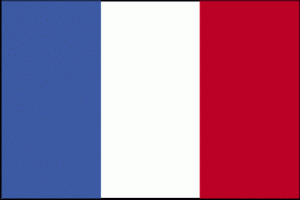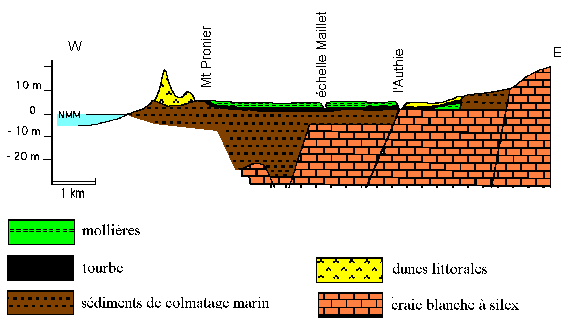
Cette cache a été spécialement conçue pour l'International Earthcache Day 2015, qui aura lieu le 11 octobre 2015.

Présentation :
L'Authie est un fleuve côtier traversant la Somme et le Pas-de-Calais qui se jette dans la Manche. Son embouchure forme une vaste baie, la Baie de l'Authie, qui est comprise entre Fort-Mahon (Somme) et Berck-sur-Mer (Pas-de-Calais).
L'ensemble de la Baie de l'Authie a été acquise par le Conservatoire du Littoral entre 1986 et 2003, dans le but de préserver la faune et la flore de ce milieu.
Cette Earthcache sera l'occasion de découvrir la géologie de la Baie de l'Authie,et d'aller ensuite la découvrir en empruntant le sentier dunaire de Berck-sur-Mer.
Merci de ne pas sortir du sentier pour éviter une érosion trop rapide de ce milieu naturel préservé. Merci également de respecter les consignes éditées au début du sentier.
Un peu de géologie :
La formation de la plaine maritime est la conséquence du colmatage de toute la région à l'ère quaternaire. Cette plaine constitue une partie de la Flandre maritime dont l'altitude varie peu par rapport au niveau marin actuel.

Figure : coupe géologique au niveau de l’Authie d’après des données de sondages (Louche, 1997)
L’ère quaternaire voit l’empilement de sables et argiles marins de la transgression « flandrienne », des tourbes et les sables marins de la transgression « dunkerquienne ». Entre les levées sableuses de transgressions marines successives, les alluvions s’évacuent mal par les différentes rivières, qui traversent une couche tourbeuse parfois épaisse de 20m, véritable sédimentation de type polder. La plaine maritime picarde est couverte de limons sableux, elle est protégée des assauts de la mer par un cordon littoral créé par l’accumulation de dépôts sableux par les courants de houle et de marée. La qualité du sol, le déversement du réseau des aquifères de la craie, sa position basse par rapport à la mer ainsi que la présence d’une nappe phréatique superficielle, en font une région où le colmatage de la plaine est propice à l’agriculture de bocage, à l’élevage, dont le caractère intensif s’est traduit par un drainage marqué. La plaine picarde est donc le témoin des variations maritimes quaternaires, de l’évolution du rivage aux temps historiques et de l’effort des hommes pour aménager ce milieu de transition entre la terre et la mer. A la fin de la transgression flandrienne se produit le colmatage de la plaine maritime picarde. La première phase de la transgression dunkerquienne provoque la formation d’un cordon littoral, qui remanie celui formé pendant la transgression flandrienne.
Un peu de géomorphologie :
Dans sa globalité, l'estuaire de l'Authie est homogène et la constitution de son terrain est la même en tout point de la baie, que ce soit à Fort-Mahon ou à Berck. De plus, le site se situe dans une zone de connectivité biologique forte, interrompue à l’Est par une limite biogéographique nette : la Falaise morte.
Sources :
http://www.eau-artois-picardie.fr/IMG/BaseDoc/aegis/2491/D_22182.pdf
https://fr.wikipedia.org/wiki/Authie_(fleuve)
Que faire pour loguer cette Earthcache ?
Deux étapes seront nécessaires pour pouvoir loguer cette cache.
Première étape : répondre aux questions suivantes (les sources vous seront très utiles ;) )
- Où l'Authie prend-elle sa source ? (Lieu et altitude) Quelle est la longueur de ce fleuve ?
- A quelle période de l'ère quaternaire a eu lieu la formation de la plaine maritime ? (Nom et dates)
- Qu'est-ce qui compose le sous-sol du sentier dunaire de Berck d'après la figure ?
- Selon vous, quelle est la hauteur de la dune visible en prenant le sentier vers le Point de Référence ?
- Quelle autoroute longe la Falaise Morte ?
Deuxième étape : (optionnelle) Au point de référence, faire une photo de vous, ou de votre GPS ou smartphone avec la date et l'heure de votre passage, devant la Baie de l'Authie (il y a normalement un banc pour vous asseoir). D'ici, il arrive souvent que l'on voit des phoques se baigner, soyez attentifs !
Loguez cette cache "Found it" et envoyez-moi vos propositions de réponses soit via mon profil, soit via la messagerie geocaching.com (Message Center) ou encore à l'adresse geosidney0@gmail.com , avec comme titre pour le mail "EarthCache La Baie d'Authie - Pseudo", et je vous contacterai en cas de problème.
N'hésitez pas à mettre la photo sur votre log si vous le souhaitez.
Le propriétaire est impatient de lire votre histoire. Merci d'en dire un peu plus qu'un simple MPLC...

This Earthcache was especially designed for the International Earthcache Day 2015, which will take place on October, 11th, 2015.

Presentation :
The Authie is a river that crosses the departements of Somme and Pas-de-Calais and it's flowing out into the Channel. The river mouth forms a sizeable bay (The "Baie de l'Authie") between Fort-Mahon (Somme) and Berck-sur-Mer (Pas-de-Calais)
The entire Baie de l'Authie has been acquired by the "Conservatoire du Littoral" between 1986 and 2003, with the goal to preserve fauna and flora in this place.
This Earthcache is here to make you discover the geology of the Baie de l'Authie et to discover it by yourself by taking a path in a dune trail in Berck-sur-Mer.
Please do not get out of the trail to avoid the erosion of this preserved natural environment. Please abide by the rules that are at the beginning of the trail. Thank you very much.
Let's talk geology :
The formation of the maritime plain is the consequence of the clogging of all the region at the quaternary. This plain is a part of the maritime Flandre whose height does not vary a lot compared with the sea level nowadays.

Figure : Geologic section near the Authie estuary according to drilling data (Louche, 1997)
The quaternary sees the stacking of sands and marine clays of the "flandrian" transgression, and peats and marine sands of the "dunkerquian" transgression. Between the sand liftings of the successives marine transgressions, the warps doesn't evacuate a lot by the different rivers, that crosses a peat layer that can be thick of 20 meters, which is a real polder-type sedimentation. The Picardy maritime plain is covered by sandy loams, she is protected from the sea assaults by a barrier beach created by the collection of sandy deposits coming from the swell, current and tides. The soil quality, the spill network of chalk aquifers, its low position compared to sea level and a superficial groundwater makes this region a place where the plain clogging is suitable for grove agriculture, rearing, whose intensive nature has resulted by a marked drainage. The plain of Picardy is the witness of quaternary marine variations, of the changing shoreline and the human try for developping this transition place between sea and land. At the end of the flandrian transgression, the clogging of the Picardy maritime plain sets up. The first step of the dunkerquian transgression induces the formation of a barrier beach, that modifies the first one which was set up during the flandrian transgression.
A bit of geomorphology :
In its entirety, the Baie de l'Authie is homogeneous and the land constitution is the same in all the bay, from Fort-Mahon to Berck. Moreover, the site is in a high biological connectivity area, that ends at the East with a clear biogeographical limit : the dead cliff.
Sources :
http://www.eau-artois-picardie.fr/IMG/BaseDoc/aegis/2491/D_22182.pdf
https://en.wikipedia.org/wiki/Authie_(river)
How to log this Earthcache ?
Two steps :
First : Please answer the following questions (see the sources)
- Where is the source of the Authie ? (City and height). How long is the Authie ?
- In which period of the quaternary did the marine plain formation begin ? (Name and dates)
- Seeing the figure, what is the composition of the Berck dune trail underground ?
- What is the approximate height of the dune you can see during the walk to the Reference Point ?
- Which highway is near the dead cliff ?
Second : (optional) At the Reference Point, take a photo of yourself with your GPS or phone with date and time in front of the Baie de l'Authie (there's a place to sit if you want), From there, you can see seals sometimes, be careful !
You can put a "Found it" and send your answers on my profile on the Message Center, or on my mail geosidney0@gmail.com with the title of the mail : "EarthCache La Baie d'Authie - Name" and I'll contact you if there's any problem.
You can put your photo with your found it if you want.
I'd love to hear your story of this cache. Don't put "TFTC" only please ;)